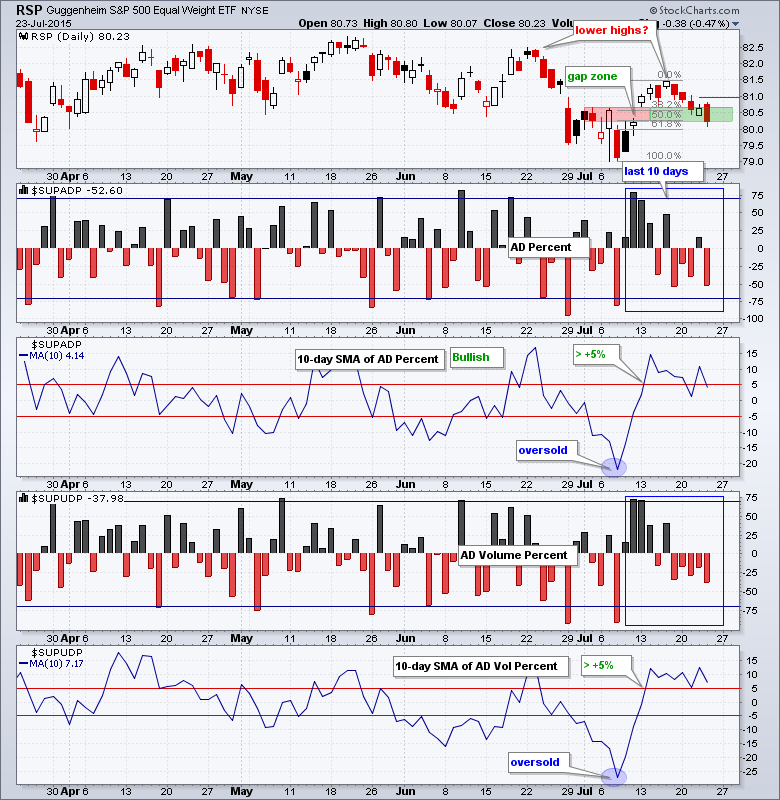Stocks were hit with selling pressure on Thursday as the major index ETFs fell across the board. The Russell 2000 iShares (IWM) led the way with a 1.1% decline. All sector SPDRs were down and eight of the nine equal-weight sector ETFs were down. The EW Energy ETF was the lone gainer. Utilities, materials and industrials led the way lower. These three have been in downtrends so further weakness is not surprising. There were some pockets of strength in technology as the Networking iShares (IGN), Cyber Security ETF (HACK) and Semiconductor SPDR (XSD) gained.
**This chart analysis is for educational purposes only, and should not
be construed as a recommendation to buy, sell or sell-short said securities**
Short-term Overview (Friday, 24-July-2015):
- Short-term Breadth is bullish.
- Four of the five Equal-weight Sector ETFs are in uptrends.
- SPY is testing uptrend support.
- QQQ fell back, but remains well above first support.
- IWM filled the mid July gap and is in a downtrend.
- TLT broke out to start an uptrend.
- UUP is in a short-term uptrend.
- USO is in a short-term downtrend.
- GLD is in a short-term downtrend.
The Equal-Weight S&P 500 ETF (RSP) fell back over the last five days and is testing the gap zone. Actually, it has completely filled the gap zone and retraced 50-62% of its mid July surge. This is the moment-of-truth for the pullback. I would mark a mini-resistance level at 81. A break here would suggest an end to the pullback and continuation of the July surge.
Breadth was negative on Thursday with AD Percent exceeding -50%. Notice that AD Percent has been negative four of the last five days and AD Volume Percent has been negative the last five days. The 10-day SMAs remain in positive territory, but the next two days will be key because the two big up days will drop out of the 10-day SMAs.
Four of the five equal-weight sector ETFs are in short-term uptrends. There is some concern with the Equal-Weight Consumer Discretionary ETF (RCD) because a lower high formed over the last two weeks. I am not ready to call this one bearish, but could conceivably label it neutral because it turned down at the June high. The Equal-weight Industrials ETF (RGI) continued its break down and remains the weakest. The Equal-weight Healthcare ETF (RYH) is the strongest.
**************************************************************

**************************************************************

**************************************************************

**************************************************************

**************************************************************

**************************************************************

**************************************************************

***************************************************************
Key Reports and Events (all times Eastern):
Fri - Jul 24 - 10:00 - New Home Sales
Mon - Jul 27 - 08:30 - Durable Goods Orders
Tue - Jul 28 - 09:00 - Case-Shiller Housing Index
Tue - Jul 28 - 10:00 - Consumer Confidence
Wed - Jul 29 - 07:00 - MBA Mortgage Index
Wed - Jul 29 - 10:00 - Pending Home Sales
Wed - Jul 29 - 10:30 - Crude Inventories
Wed - Jul 29 - 14:00 - FOMC Rate Decision
Thu - Jul 30 - 08:30 - Initial Jobless Claims
Thu - Jul 30 - 08:30 - GDP
Thu - Jul 30 - 10:30 - Natural Gas Inventories
Fri - Jul 31 - 09:45 - Chicago PMI
This commentary is designed to stimulate thinking. This analysis is not a recommendation to buy, sell, hold or sell short any security (stock ETF or otherwise). We all need to think for ourselves when it comes to trading our own accounts. First, it is the only way to really learn. Second, we are the only ones responsible for our decisions. Think of these charts as food for further analysis. Before making a trade, it is important to have a plan. Plan the trade and trade the plan. Among other things, this includes setting a trigger level, a target area and a stop-loss level. It is also important to plan for three possible price movements: advance, decline or sideways. Have a plan for all three scenarios BEFORE making the trade. Consider possible holding times. And finally, look at overall market conditions and sector/industry performance.








